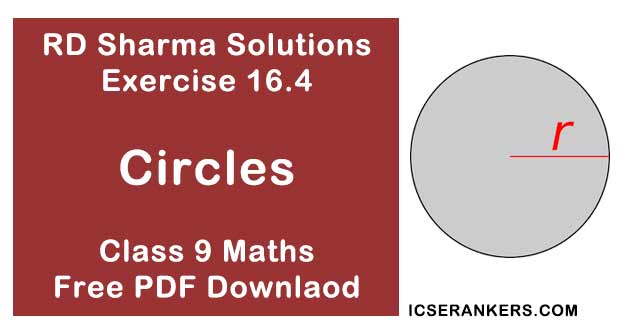Chapter 16 Circles RD Sharma Solutions Exercise 16.4 Class 9 Maths

Chapter Name | RD Sharma Chapter 16 Circles Exercise 16.4 |
Book Name | RD Sharma Mathematics for Class 10 |
Other Exercises |
|
Related Study | NCERT Solutions for Class 10 Maths |
Exercise 16.4 Solutions
1. In the below fig. O is the centre of the circle. If ∠APB = 50°, find ∠AOB and ∠OAB.
Solution

2. In the fig below, it is given that O is the centre of the circle and ∠AOC = 150°. Find ∠ABC.
Solution

3. In the below fig. O is the centre of the circle. Find ∠BAC.
Solution

4. If O is the centre of the circle, find the value of x in each of the following figures :
Solution
(i) ∠AOC = 135°
∴ ∠AOC + ∠BOC = 180° [Linear pair of angles]
⇒ 135° + ∠BOC = 180°
⇒ ∠BOC = 180° - 135° = 45°
By degree measures theorem
∠BOC = 2∠CDB
⇒ 45° = 2x
⇒x = 45/2 = 22.5°
(ii) We have
∠ABC = 40°
∠ACB = 90° [Angle in semicircle]
In ΔABC, by angle sum property
∠CAB + ∠ACB + ∠ABC = 180°
⇒ ∠CAB + 90° +40° = 180°
⇒∠CAB = 180° - 130°
⇒ ∠CAB = 50°
Now,
∠COB = ∠CAB [Angle is same segment]
⇒ x = 50°
(iii) We have
∠AOC = 120°
By degree measure theorem
∠AOC = 2∠APC
⇒ 120° = 2∠APC
⇒ ∠APC = 120°/2 = 60°
∠APC + ∠ABC = 180° [Opposite angles of cyclic quadrilateral]
⇒ 60° + ∠ABC = 180°
⇒ ∠ABC = 180° - 60°
⇒ ∠ABC = 120°
∴ ∠ABC + ∠DBC = 180° [Linear pair of angles]
⇒ 120° + x = 180°
⇒ x = 180° - 120° = 60°
(iv) We have
∠CBD = 65°
∴ ∠ABC + ∠CBD = 180° [Linear pair of angles]
⇒ ∠ABC + 65° = 180°
⇒ ∠ABC = 180° - 65° = 115°
∴ Reflex ∠AOC = 2∠ABC [By degree measure theorem]
⇒ x = 2 × 115°
⇒ x = 230°
(v) We have
∠OAB = 35°
Then, ∠OBA = ∠OAB = 35° [Angles opposite to equal radii]
In ΔAOB, by angle sum property
∠AOB + ∠OAB + ∠OBA = 180°
⇒ ∠AOB + 35° + 35° = 180°
⇒ ∠AOB = 180° - 70° = 110°
∴∠AOB + reflex ∠AOB = 360° [complete angle]
⇒ 110° + reflex ∠AOB = 360°
⇒ reflex ∠AOB = 360° - 110° = 250°
By degree measure theorem reflex ∠AOB = 2∠ACB
⇒ 250° = 2x
⇒ x = 250°/2 = 125°
(vi) We have
∠AOB = 60°
By degree measure theorem
∠AOB = 2∠ACB
⇒ 60° = 2∠ACB
⇒ ∠ACB =60°/2 = 30° [Angles opposite to equal radii]
⇒ x = 30°
(vii) We have
∠BAC = 50°
And ∠DBC = 70°
∴ ∠BDC = ∠BAC = 50° [Angle in same segment]
In ΔBDC, by angles sum property
∠BDC + ∠BCD + ∠DBC = 180°
⇒ 50° + x + 70° = 180°
⇒ x = 180° - 70° - 50° = 60°
(viii) We have
∠DBO = 40°
∠DBC = 90° [Angle in semi circle]
⇒ ∠DBO + ∠OBC = 90°
⇒ 40° + ∠OBC = 90°
⇒ ∠OBC = 90° - 40° = 50°
By degree measure theorem
∠AOC = 2∠OBC
⇒ x = 2 × 50° = 100°
(ix) In ΔDAB, by angle sum property
∠ADB + ∠DAB + ∠ABD = 180°
⇒ 32° + ∠DAB + 50° = 180°
⇒ ∠OAB = 180° - 32° - 50°
⇒ ∠DAB = 95°
Now, ∠OAB + ∠DCB = 180° [Opposite angles of cyclic quadrilateral]
⇒ 98° + x = 180°
⇒ x = 180° - 98° = 82°
(x) we have
∠BAC = 35°
∠BAC = ∠BAC = 35° [Angle in same segment]
In ΔBCD by angle sum property
∠BDC + ∠BCD + ∠DBC = 180°
⇒ 35° + x + 65° = 180°
⇒ x = 180° - 35° - 66° = 80°
(xi) We have
∠ABD = 40°
∴ ∠ACD = ∠ABD = 40° [Angle in same segment]
In ΔPCD, by angle sum property
∠PCD + ∠CPO + ∠PDC = 180°
⇒ 40° + 110° + x = 180°
⇒ x = 180° - 150°
⇒ x = 30°
(xii) Given that ∠BAC = 52°
Then, ∠BDC = ∠BAC = 52° [Angle in same segment]
Since OD = OC
Then, OD = OC
Then, ∠ODC = ∠OCD
⇒ x = 50°
5. O is the circumcenter of the triangle ABC and OD is perpendicular on BC. Prove that ∠BOD = ∠A.
Solution
Given O is the circumcenter of ΔABC and OD ⊥ BC
To prove ∠BOD = 2∠A
Proof :

Then, ∠ABO = ∠DAB ...(2) [Opposite angles to equal sides]
Since OB = OC [Radius of circle]
The ∠CBO = ∠OCB ...(3) [Opposite angles to equal sides]
∠OAB = ∠OCB ...(4)
In ∠OAB = ∠OCB [From (4)]
∠OBA = ∠OBC [Given]
OB = OB [Common]
Then, ΔOAB ≅ OCB [By AAS condition]
∴ AB = BC [c.p.c.t]
7. In the below fig. O is the centre of the circle, prove that ∠x = ∠y + ∠z.





∴ ∠PRQ + ∠TRQ = 180° [Linear pair of angle]
By degree measure theorem
⇒ 40° = 2∠RQS
⇒ ∠RQS = 40°/2 = 20°
In ΔRQT, By angle sum property
∠RQT + ∠QRT + ∠RTS = 180°
⇒ 20° + 90° + ∠R + ∠S = 180°
⇒ ∠RTS = 180° - 20° - 90° = 70°









